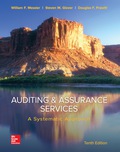
EBK AUDITING & ASSURANCE SERVICES: A SY
10th Edition
ISBN: 9781259293245
Author: Jr
Publisher: MCGRAW HILL BOOK COMPANY
expand_more
expand_more
format_list_bulleted
Question
Chapter 18, Problem 18.20MCQ
To determine
Introduction:
Financial statements prepared in accordance with income tax accounting makes recognition of expenses and income based on
Net profit calculated using taxation accounting often differs from net profit derived from following GAAP because of differential treatment of items of financial statements.
The framework for preparation of financial statements is selected by the management based on the purpose for which the statements are to be used, the auditor ensures that the disclosure of framework followed is made in his audit report and ensures that the statements are as per the required framework.
To select: The correct option.
Expert Solution & Answer
Want to see the full answer?
Check out a sample textbook solution
Students have asked these similar questions
Create financial forecasting years 2022, 2023, and 2024 using this balance sheet.
Beta Company Ltd issued 10% perpetual debt of Rs. 1,00,000. The company's tax rate is 50%.
Determine the cost of capital (before tax as well as after tax) assuming the debt is issued at 10 percent premium. help
Finance subject qn solve.
Chapter 18 Solutions
EBK AUDITING & ASSURANCE SERVICES: A SY
Ch. 18 - Prob. 18.1RQCh. 18 - Prob. 18.2RQCh. 18 - Prob. 18.3RQCh. 18 - Prob. 18.4RQCh. 18 - Prob. 18.5RQCh. 18 - Prob. 18.6RQCh. 18 - Prob. 18.7RQCh. 18 - Prob. 18.8RQCh. 18 - Prob. 18.9RQCh. 18 - Prob. 18.10MCQ
Ch. 18 - Prob. 18.11MCQCh. 18 - Prob. 18.12MCQCh. 18 - Prob. 18.13MCQCh. 18 - Prob. 18.14MCQCh. 18 - Prob. 18.15MCQCh. 18 - Prob. 18.16MCQCh. 18 - Prob. 18.17MCQCh. 18 - Prob. 18.18MCQCh. 18 - Prob. 18.19MCQCh. 18 - Prob. 18.20MCQCh. 18 - Prob. 18.21MCQCh. 18 - Prob. 18.22PCh. 18 - Prob. 18.23PCh. 18 - Prob. 18.24PCh. 18 - Prob. 18.25PCh. 18 - Prob. 18.26PCh. 18 - Prob. 18.27PCh. 18 - Prob. 18.28P
Knowledge Booster
Learn more about
Need a deep-dive on the concept behind this application? Look no further. Learn more about this topic, finance and related others by exploring similar questions and additional content below.Similar questions
arrow_back_ios
SEE MORE QUESTIONS
arrow_forward_ios
Recommended textbooks for you
 Auditing: A Risk Based-Approach to Conducting a Q...AccountingISBN:9781305080577Author:Karla M Johnstone, Audrey A. Gramling, Larry E. RittenbergPublisher:South-Western College Pub
Auditing: A Risk Based-Approach to Conducting a Q...AccountingISBN:9781305080577Author:Karla M Johnstone, Audrey A. Gramling, Larry E. RittenbergPublisher:South-Western College Pub Auditing: A Risk Based-Approach (MindTap Course L...AccountingISBN:9781337619455Author:Karla M Johnstone, Audrey A. Gramling, Larry E. RittenbergPublisher:Cengage Learning
Auditing: A Risk Based-Approach (MindTap Course L...AccountingISBN:9781337619455Author:Karla M Johnstone, Audrey A. Gramling, Larry E. RittenbergPublisher:Cengage Learning



Auditing: A Risk Based-Approach to Conducting a Q...
Accounting
ISBN:9781305080577
Author:Karla M Johnstone, Audrey A. Gramling, Larry E. Rittenberg
Publisher:South-Western College Pub

Auditing: A Risk Based-Approach (MindTap Course L...
Accounting
ISBN:9781337619455
Author:Karla M Johnstone, Audrey A. Gramling, Larry E. Rittenberg
Publisher:Cengage Learning
Accounting Basics Explained Through a Story; Author: Leila Gharani;https://www.youtube.com/watch?v=VYNTBWBqncU;License: Standard Youtube License